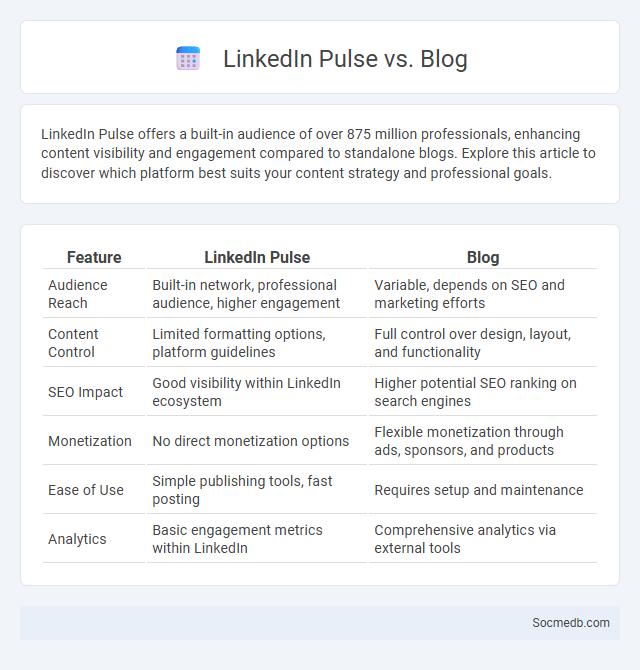
Photo illustration: LinkedIn Pulse vs Blog
LinkedIn Pulse offers a built-in audience of over 875 million professionals, enhancing content visibility and engagement compared to standalone blogs. Explore this article to discover which platform best suits your content strategy and professional goals.
Table of Comparison
| Feature | LinkedIn Pulse | Blog |
|---|---|---|
| Audience Reach | Built-in network, professional audience, higher engagement | Variable, depends on SEO and marketing efforts |
| Content Control | Limited formatting options, platform guidelines | Full control over design, layout, and functionality |
| SEO Impact | Good visibility within LinkedIn ecosystem | Higher potential SEO ranking on search engines |
| Monetization | No direct monetization options | Flexible monetization through ads, sponsors, and products |
| Ease of Use | Simple publishing tools, fast posting | Requires setup and maintenance |
| Analytics | Basic engagement metrics within LinkedIn | Comprehensive analytics via external tools |
Understanding LinkedIn Pulse: Features and Benefits
LinkedIn Pulse offers a powerful platform for sharing industry insights, enhancing professional visibility, and connecting with a targeted audience. Its features include personalized content feeds, article publishing, and analytics that help you track engagement and reach. Leveraging LinkedIn Pulse can significantly boost your personal brand and establish you as a thought leader in your field.
Traditional Blogging Platforms: An Overview
Traditional blogging platforms like WordPress, Blogger, and Tumblr serve as foundational tools for individuals and businesses to publish long-form content and build online communities. These platforms offer customizable templates, SEO features, and integration with social media, enabling content creators to enhance visibility and engagement. As key players in digital marketing strategies, traditional blogs remain essential for in-depth storytelling, thought leadership, and driving organic traffic.
Defining Pulse: Clarifying the Terminology
Defining pulse in social media involves understanding it as the real-time measurement of audience engagement and trending topics that reflect current user interests. Your ability to analyze these metrics provides crucial insights into content performance and community sentiment. Mastering the terminology around pulse helps optimize social media strategies for increased relevance and impact.
Audience Reach: LinkedIn Pulse vs Blogs
LinkedIn Pulse offers a highly targeted audience reach, connecting Your content directly with professionals and industry influencers, which enhances visibility among decision-makers. Blogs provide broader flexibility in content format and style, enabling you to attract diverse readership through SEO optimization and social sharing. Choosing between LinkedIn Pulse and traditional blogs depends on whether Your goal is niche professional engagement or expansive audience growth.
Content Control and Ownership
Your content on social media platforms should be managed carefully to maintain control and protect ownership rights. Content control involves setting privacy settings, monitoring sharing permissions, and securing intellectual property through copyrights or trademarks. Understanding platform policies and using digital rights management tools ensures your original work remains yours and prevents unauthorized use or distribution.
SEO Impact: Comparing Blog Posts and Pulse Articles
Social media platforms significantly influence SEO impact by driving traffic and engagement to content, with blog posts often yielding higher search engine rankings due to their optimized keywords and comprehensive structure. Pulse articles, while effective for quick updates and thought leadership, typically generate less sustained SEO value because of their shorter lifespan and limited keyword targeting. Consistent social media sharing of blog posts enhances backlink opportunities and domain authority, boosting overall SEO performance more effectively than Pulse articles.
Engagement and Networking Opportunities
Social media platforms maximize engagement by facilitating real-time interactions through comments, likes, and shares that boost your content visibility. Networking opportunities expand as users connect with industry leaders, join niche groups, and participate in live discussions that cultivate professional relationships. Tailoring your social media strategy to prioritize authentic engagement enhances brand loyalty and broadens your reach within targeted communities.
Analytics and Performance Tracking
Social media analytics involves the systematic collection and evaluation of data from platforms such as Facebook, Instagram, and Twitter to measure user engagement, reach, and conversion rates. Performance tracking tools like Google Analytics and native platform insights enable marketers to optimize content strategy by identifying high-performing posts and audience demographics. Leveraging these analytics enhances campaign effectiveness, increases ROI, and supports data-driven decision-making across social marketing efforts.
Monetization Potential: Pulse vs Blog
Pulse offers excellent monetization potential through native advertising and sponsored content integrated seamlessly within its professional network, maximizing visibility among engaged business audiences. Blogs provide flexible revenue streams including affiliate marketing, direct ad placements, and subscription models, allowing You to tailor monetization strategies to niche topics and dedicated readers. Choosing between Pulse and Blog depends on Your audience targeting and preferred advertising formats to optimize earnings.
Choosing the Right Platform for Your Content Strategy
Selecting the ideal social media platform hinges on understanding audience demographics, content format, and engagement rates. Instagram and TikTok excel for visual storytelling and reaching younger users, while LinkedIn targets professionals and B2B content efficiently. Analyzing platform analytics and aligning them with your business goals ensures optimized content distribution and higher conversion rates.
 socmedb.com
socmedb.com